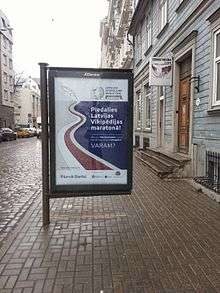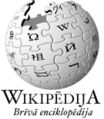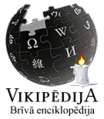Latvian Wikipedia
 | |
 | |
Type of site | Internet encyclopedia |
|---|---|
| Owner | Wikimedia Foundation |
| Slogan(s) | Brīva enciklopēdija |
| Website | lv.wikipedia.org |
| Commercial | No |
| Registration | Optional |
| Users |
62,413 registered accounts 1,435 contributors[lower-alpha 1] (July 2014) |
| Launched | 6 June 2003 |
Content license |
CC Attribution / Share-Alike 3.0 Most text also dual-licensed under GFDL. Media licensing varies. |
The Latvian Wikipedia (Latvian: Vikipēdija latviešu valodā [ˈvikipɜːdija]) is the Latvian-language edition of the free online encyclopedia Wikipedia. It was created on 6 June 2003.[2][3][4] With about 74,000 articles, it is currently the 64th-largest Wikipedia as measured by the number of articles[5] and the second-largest Wikipedia in a Baltic language.[6]
History
The Latvian Wikipedia was created alongside the Serbian, Kannada, Walloon, Wolof, and Xhosa Wikipedias.[3] The oldest article is "Psihologija", which was published on 6 June 2003 and redirected to "Psiholoģija" (psychology) on 7 December 2004.[7] The main page was added four months after the first article, on 6 October 2003.[8]
The edition's initial growth was slow and some articles about important aspects of Latvian culture were missing at first.[2] The article about Jāņi, for instance, was not written until March 2008.[9] The Latvian Wikipedia's growth rate has been very stable since 2006.[10]
On 30 September 2013, the VisualEditor was made available to logged-in users, and by 7 October 2013, it was available to all users on the Latvian Wikipedia.[11]
The Latvian Wikipedia turned 10 years old on 6 June 2013. A commemorative logo was uploaded for the occasion, and small parties among the community's "Wikiholics" ensued, as it is customary whenever a new milestone is reached.[12] The edition surpassed 50,000 articles on 17 August 2013.[4]
As of July 2014, according to the list of Wikipedias by sample of articles at Meta-Wiki, which is based on the list of articles every Wikipedia should have, the Latvian Wikipedia ranks 52nd out of 287 editions, with a score of 20.83/100. It lacks almost no article from the list of vital articles, but contains generally short articles.
Name and logo
On 22 September 2004, the first Latvian "Wikipēdija" logo was uploaded, and on 1 June 2005, the name was changed to "Vikipēdija".[13] In Latvian media, the words "Wikipedia" and "Vikipēdija" are used interchangeably to refer to both Wikipedia in general and to the Latvian edition specifically, but "Vikipēdija" is more common.[14][15]
In response to the Zolitūde shopping centre roof collapse disaster of 21 November 2013, the Latvian Wikipedia, just as several other Latvian websites, changed its logo for three days to include black and the image of a candle.
Related projects
A separate Latgalian Wikipedia (ltg) has been created on 18 March 2011.[16] Latgalian is spoken in Latgale, the eastern part of Latvia, and its standardized form is recognized and protected as a variety of Latvian language by Latvian law,[17] although it is debated whether it is a dialect of Latvian or a separate language.[18]
Milestones
|
 |
Latvian Wikipedia Marathon

Latvian Wikipedia Marathon (Latvian: Latvijas Vikipēdijas maratons) is a project that brings together the Latvian Wikipedia community with several private partners in joint effort with the aim of expanding the Latvian Wikipedia to activate the usability of the Latvian language in the learning process, cognition and research work.
Policies
Since 31 October 2012, the Latvian Wikipedia displays a notice encouraging users to sign a petition on the Latvian social initiative platform ManaBalss.lv in an effort to change the Latvian copyright law, which permits taking pictures of architectural works and monuments, but only for non-commercial purposes. According to the petition, "such restrictions are not reasonable for buildings, monuments, sculptures and other three-dimensional works that cannot be fully reproduced in two dimensions".[2][19] If the law changed, pictures of Latvian public buildings would become valid on Wikimedia Commons.
- As opposed to the English Wikipedia, it is not required to be logged-in to create a new article on the Latvian Wikipedia.
- Many users use personalized license templates on the images they upload locally to have them grouped.[20]
- Unlike most major Wikipedias, the Latvian Wikipedia adopted gadgets very late, in May 2014.[21]
Images
The Latvian Wikipedia has an Exemption Doctrine Policy (Godprātīga lietošana) that allows local uploads of non-free, fair use images and audio/video files (with copyright restrictions). However, users are encouraged to release their work under a Creative Commons license and upload it on Wikimedia Commons instead, thus making it accessible throughout all editions of Wikipedia. This stance is similar to the English Wikipedia's, and in contrast to some other editions, which rely strictly on Wikimedia Commons for images, sound, and other media files, including i.a. the Spanish, Swedish, Polish, Basque, Czech, Danish, Volapük and Latin Wikipedias.[5][22][23]
Content and images from the Latvian Wikipedia often appear on Latvian news websites.[24][25][26][27]
Statistics
As of December 2016, the Latvian Wikipedia's 74,000 articles[5] account for approximately 27% of all the articles written in a Baltic language, making it the second-largest edition in the family after Lithuanian, which accounts for 66%.[6] The most popular articles are "Latvija" (Latvia), "Eiropa" (Europe), and "Latvijas vēsture" (History of Latvia).[2][28][29]
In terms of quality, as of July 2014, the Latvian Wikipedia has 49 featured articles (vērtīgi raksti),[30] 76 good articles (labi raksti),[31] 19 featured lists (vērtīgi saraksti),[32] and an average ratio of 0.9 featured articles per 1000 articles; on par with the Bulgarian, Spanish, and English Wikipedias. It currently has a high depth indicator of 83.2,[lower-alpha 2] which is not only greater than those of all other Wikipedias in the language family combined,[lower-alpha 3] but also than some of the largest editions such as German (100.4), Polish (23.8), and Dutch (13). As of March 2015, there are 17 Wikiprojects (Vikiprojekts) on the Latvian Wikipedia,[33] and 81 approved bots, assisting users in the editing process.[34]
Community
The Latvian Wikipedia is the third most read edition in Latvia, after the English Wikipedia and the Russian Wikipedia.[35] It is also the seventh most read edition on the island of Guernsey,[35] where there is an emerging Latvian diaspora of approximately 1,500 to 2,000 migrant workers.[36] Despite Latvian having less than 2 million speakers, the edition enjoys a relatively high level of community participation, with 54 editors per million speakers, even though there is still no Wikimedia chapter in Latvia.[37] At around 37.2 articles per speaker, the Latvian Wikipedia has an above-average number of articles per speaker.[38] These figures were based on an estimate of 1.8 million speakers of Latvian.[39] Its editing community currently consists of 12 administrators (4.18% of all active users) and 287 active contributors, of which on average between 12 and 20 are very active every month,[lower-alpha 4] and there are in total 62 users with over 1,000 edits (excluding bots).[40][41] Around 90% of both views and edits originate from Latvia, where Wikipedia is the 14th most popular website.[42]
Gallery
 The Latvian Wikipedia's original logo. Note that "Wikipēdija" was spelled with a 'W' from 22 September 2004 to 1 June 2005
The Latvian Wikipedia's original logo. Note that "Wikipēdija" was spelled with a 'W' from 22 September 2004 to 1 June 2005 The Latvian Wikipedia's 50,000 articles commemorative logo (17 August 2013)
The Latvian Wikipedia's 50,000 articles commemorative logo (17 August 2013) The logo displayed in memory of the victims of the Zolitūde shopping centre roof collapse (23–26 November 2013)
The logo displayed in memory of the victims of the Zolitūde shopping centre roof collapse (23–26 November 2013)
See also
Notes
- ↑ Contributors are users who edited at least 10 times since they registered.[1]
- ↑ Depth is a rough indicator of a Wikipedia's collaborative quality showing how frequently its articles are updated. A higher depth usually indicates that articles are more often edited.
- ↑ The Lithuanian, Samogitian, and Latgalian Wikipedias have a depth indicator of 21.7, 5.8, and 63.7 respectively.
- ↑ A very active user is one with 100+ edits in the main namespace of a given project over the last 30 days.
References
- ↑ "Wikipedia Statistics — Tables — Contributors". stats.wikimedia.org. Retrieved 18 May 2014.
- 1 2 3 4 ""Vikipēdijas" latviešu versijai jau desmit gadi" (in Latvian). Neatkarīgā Rīta Avīze. 5 June 2013. Retrieved 21 July 2014.
- 1 2 Zachte, Erik. "Creation history / Accomplishments". stats.wikimedia.org. Retrieved 9 May 2014.
- 1 2 "Vikipēdija:Aktualitātes". Vikipēdija (in Latvian). Wikimedia Foundation. Retrieved 11 May 2014.
- 1 2 3 "List of Wikipedias". Meta-Wiki. Wikimedia Foundation. Retrieved 15 December 2016.
- 1 2 3 "List of Wikipedias by language group". Meta-Wiki. Wikimedia Foundation. Retrieved 9 May 2014.
- ↑ "Raksta "Psiholoģija" vēsture" (in Latvian). Vikipēdija. Retrieved 9 May 2014.
- ↑ "Raksta "Sākumlapa" vēsture" (in Latvian). Vikipēdija. Retrieved 9 May 2014.
- ↑ "Links — Reference". Latvians Online. Archived from the original on 13 May 2014. Retrieved 12 May 2014.
Incidentally, seeing as Jāņi is fast approaching, we searched Vikipēdija but came up with nothing. The English version, though, does have quite a comprehensive section on the subject of "Midsummer," covering the whole region of Northern Europe and the way it celebrates this time of the year.
- ↑ Zachte, Erik. "Wikipedia Statistics — Europe — Contributors". stats.wikimedia.org. Retrieved 12 May 2014.
- ↑ "VisualEditor". MediaWiki. Wikimedia Foundation. Retrieved 12 May 2014.
- ↑ Elīna, Zalāne (7 June 2013). "Latviešu Vikipēdija svin 10 gadu jubileju" (in Latvian). Diena. Retrieved 12 May 2014.
- ↑ "Aizvien par "Wikipēdija" / "Vikipēdija"" (in Latvian). Vikipēdija. Retrieved 12 May 2014.
- ↑ "Vikipēdijas krievu valodas versija pārtrauc darbu, protestējot pret interneta cenzēšanu" (in Latvian). Kasnotiek.com. 10 July 2012. Retrieved 13 May 2014.
- ↑ "Pirmā persona, kas iegūst savu "Wikipedia" lapu vēl pirms piedzimšanas" (in Latvian). DELFI.lv. Retrieved 12 May 2014.
- ↑ ""Wikipedia" jau turi versiją latgalių kalba" (in Lithuanian). DELFI.lt. 4 April 2011. Retrieved 18 May 2014.
- ↑ "Valsts valodas likums" (in Latvian). Likumi.lv. 1 September 2000. Retrieved 18 May 2014.
- ↑ Ina Druviete (22 July 2001). "Recenzija par pētījumu "Valodas loma reģiona attīstībā"" (in Latvian). politika.lv. Retrieved 18 May 2014.
- ↑ "MediaWiki:Sitenotice" (in Latvian). Vikipēdija. Retrieved 12 May 2014.
- ↑ "Kategorija:Individuālās attēlu autortiesību veidnes" (in Latvian). Vikipēdija. Retrieved 13 May 2014.
- ↑ "Dažas fīčas". Vikipēdija. 9 May 2014. Retrieved 21 July 2014.
- ↑ "Non-free content". Meta-Wiki. Wikimedia Foundation. Retrieved 12 May 2014.
- ↑ "Londona iet ar kājām" (in Latvian). Kasjauns.lv. 5 February 2014. Retrieved 12 May 2014.
- ↑ "Kapteinis Herberts Cukurs" (in Latvian). TVNET/LETA. 17 April 2014. Retrieved 12 May 2014.
- ↑ "Ainaram Bagatskim paskaidrojums no wikipedia.org" (in Latvian). Kasjauns.lv. 31 January 2011. Retrieved 12 May 2014.
- ↑ "Halovīns ir klāt" (in Latvian). Kasjauns.lv. 31 October 2013. Retrieved 12 May 2014.
Halovīns Visu svēto dienas priekšvakars, 31. oktobra vakars. Šajā vakarā cilvēki pārģērbjas par spokiem, raganām, miroņiem un citiem mošķiem un staigā pa mājām, prasot saldumus. Tā ir ASV tradīcija, taču globalizācijas rezultātā šī tradīcija tiek pārnesta arī uz citām valstīm, arī Latviju. Info: Wikipedia [...] Tesmeņveidīgie mākoņi jeb maisveida mākoņi ir mākoņi ar nokareniem puslodes formas izspiedumiem to apakšdaļā. Šie izspiedumi tiecas uz leju līdzīgi tesmeņiem vai nokarenām kabatām. No tā radies mākoņu nosaukums. Šādi mākoņi retumis novērojami negaisa mākoņu aizmugurē vasaras periodā. Info: Wikipedia
- ↑ "Tesmeņveidīgo mākoņu neparastais skaistums" (in Latvian). Kasjauns.lv. 23 January 2014. Retrieved 12 May 2014.
Tesmeņveidīgie mākoņi jeb maisveida mākoņi ir mākoņi ar nokareniem puslodes formas izspiedumiem to apakšdaļā. Šie izspiedumi tiecas uz leju līdzīgi tesmeņiem vai nokarenām kabatām. No tā radies mākoņu nosaukums. Šādi mākoņi retumis novērojami negaisa mākoņu aizmugurē vasaras periodā. Info: Wikipedia
- ↑ "Yearly wiki page Hits for lv.wikipedia". wikistics.falsikon.de. Retrieved 12 May 2014.
- ↑ "Latviešu Vikipēdijas apmeklētāko rakstu" (in Latvian). blogtop.lv. Retrieved 12 May 2014.
- ↑ "Vikipēdija:Vērtīgi raksti". Vikipēdija (in Latvian). Retrieved 19 July 2014.
- ↑ "Vikipēdija:Labi raksti". Vikipēdija (in Latvian). Retrieved 19 July 2014.
- ↑ "Vērtīgi saraksti". Vikipēdija (in Latvian). Retrieved 19 July 2014.
- ↑ "Vikipēdija:Vikiprojekts". Vikipēdija (in Latvian). Retrieved 19 July 2014.
- ↑ "Vikipēdija:Boti" (in Latvian). Vikipēdija. Retrieved 13 July 2014.
- 1 2 Zachte, Erik. "Wikimedia Traffic Analysis Report — Wikipedia Page Views Per Country — Trends". Retrieved 11 May 2014.
- ↑ Lulle, Aija (22 January 2014). "Latvians in Guernsey an Emerging Translocal Labor Diaspora" (PDF). Baltic Worlds. VI:3-4: 10–16. Retrieved 11 May 2014.
- ↑ Zachte, Erik. "Wikipedia Statistics — Sitemap". stats.wikimedia.org. Retrieved 11 May 2014.
- ↑ "List of Wikipedias by speakers per article". Meta-Wiki. Wikimedia Foundation. Retrieved 10 May 2014.
- ↑ Латышский язык, языки в Латвии (PDF) (in Russian). Valsts valodas komisija. 2003. ISBN 9984720365. Retrieved 11 May 2014.
- ↑ Zachte, Erik. "50 recently active wikipedians, excl. bots, ordered by number of contributions". stats.wikimedia.org. Retrieved 11 May 2014.
- ↑ "Analytics/Metric definitions". MediaWiki, The Free Wiki Engine. Retrieved 11 April 2013.
- ↑ "Top Sites in Latvia". Alexa Internet, Inc. Retrieved 11 May 2014.
External links
| Latvian edition of Wikipedia, the free encyclopedia |
| Meta has related information at: Tell us about Latvian Wikipedia |
-
 Media related to Latvian Wikipedia at Wikimedia Commons
Media related to Latvian Wikipedia at Wikimedia Commons - Latvian Wikipedia (Latvian)
- Latvian Wikipedia (mobile) (Latvian)
- Twitter page of the Latvian Wikipedia (Latvian)
- Embassy of the Latvian Wikipedia (English, French, German, Polish, and Russian)
